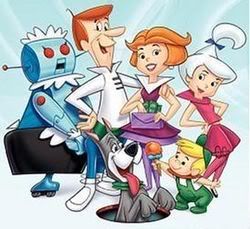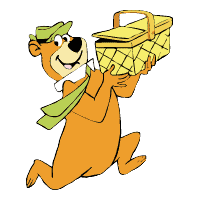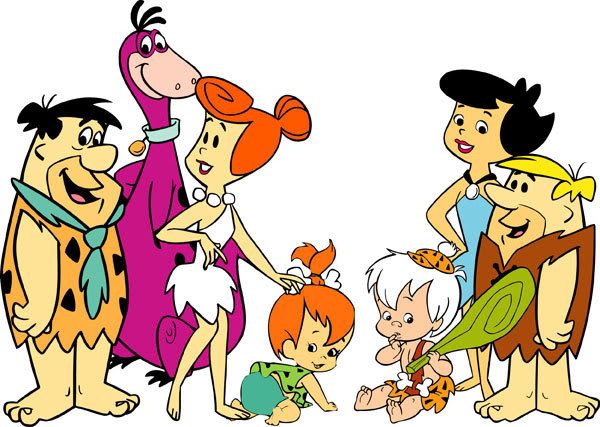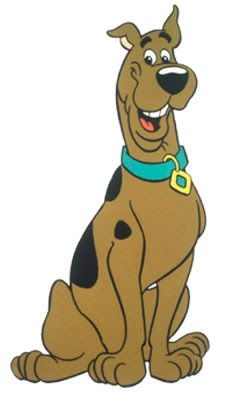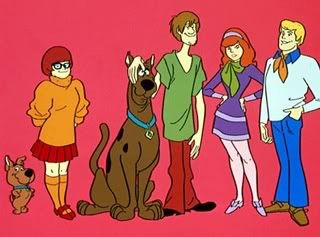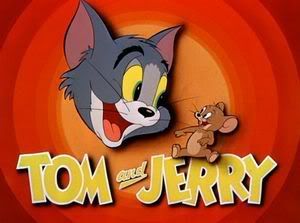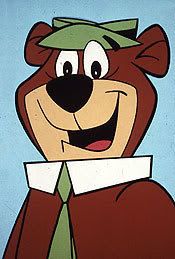
Yogi Bear is a fictional anthropomorphic bear who appears in animated cartoons created by Hanna-Barbera Studios. He made his debut in 1958 as a supporting character in The Huckleberry Hound Show. In 1961 he was given his own show, The Yogi Bear Show, which also included the segments Snagglepuss and Yakky Doodle. Hokey Wolf replaced his segment on The Huckleberry Hound Show. There was a musical animated feature film, Hey There, It's Yogi Bear!, in 1964.
Like many Hanna-Barbera characters, Yogi's personality and mannerisms were based on a popular celebrity of the time. Art Carney's Ed Norton character on The Honeymooners was said to be Yogi's inspiration. Yogi's name is a nod to the famed baseball star Yogi Berra.
The plot of most of Yogi's cartoons centered around his antics in the fictional Jellystone Park, a takeoff on the famous Yellowstone National Park. There had been a 1941 Bugs Bunny cartoon, Wabbit Twouble, that used the more obvious name "Jellostone" Park, a play on both the name of the national park and the dessert Jell-O. Yogi, accompanied by his reluctant best friend Boo Boo, would often try to steal picnic baskets from campers in the park, much to the chagrin of Park Ranger Smith. A girlfriend, Cindy Bear, turned up sometimes, and usually disapproved of Yogi's antics.
TOP 3 WELL-KNOWN HANNA-BARBERA CARTOON
"THE FLINSTONES"
The Flintstones is about a working class Stone Age man's life with his family and his next door neighbor and best friend. The first prime time cartoon geared for adults, the show originally aired from 1960 to 1966, on the ABC network. It was also ABC's first series to be televised in color. While the show was originally syndicated by Screen Gems (until 1981, then DFS Program Exchange from, and then Turner Program Services), Warner Bros. Television later acquired the rights (through parent Time Warner's purchase).
The FlintstoneS
Fred Flintstone - The main character of the show.
Wilma Flintstone (née Pebble, later Slaghoople) - Fred's ever-patient wife.
Pebbles Flintstone The Flintstones' infant daughter.
Dino - The Flintstones' pet dinosaur, which barked like a dog.
Baby Puss - The Flintstones' pet sabertoothed cat.
Pearl Slaghoople - Wilma's mother.
Tex Hardrock - Fred's uncle on his mother's side.
The Rubbles
Barney Rubble - Fred's best friend and next door neighbor
Betty Rubble (née Elizabeth Jean McBricker) - Barney's wife.
Bamm-Bamm Rubble - the Rubbles' abnormally strong adopted son.
Hoppy - The Rubbles' pet Hopparoo (a kangaroo/dinosaur combination creature)
Other characters
Mr. Slate - Fred Flintstone's boss at the stone quarry.
The Gruesomes - the Flintstone's strange next-door neighbors (inspired by the then-popular monster sitcoms The Addams Family and The Munsters)
The Great Gazoo - an alien exiled to Earth who helps Fred and Barney, often against their will. (possibly based on the Superman character Mister Mxyzptlk)
Arnold - the paper boy.
Joe Rockhead - a friend of Fred's.
Sam Slagheap - the Grand Poobah of the Loyal Order of Water Buffaloes.
TOP 2 WELL-KNOWN HANNA-BARBERA CARTOON
"SCOOBY DOO"
Scooby-Doo is a long-running American animated series produced for Saturday morning television in several different versions from 1969 to the present. The original series, Scooby-Doo, Where Are You!, was created for Hanna-Barbera Productions by writers Joe Ruby and Ken Spears, CBS executive Fred Silverman and character designer Iwao Takamoto. Hanna-Barbera produced numerous spin-offs and related works until being absorbed in 1997 into Warner Bros. Animation, which has handled production since then. Although the format of the show and the cast (and ages) of characters have varied significantly over the years, the most familiar versions of the show feature a talking dog named Scooby-Doo and four teenagers: Fred "Freddie" Jones, Daphne Blake, Velma Dinkley, and Norville "Shaggy" Rogers.
These five characters (officially collectively known as "Mystery, Inc.", but never referred to as such in the original series) drive around the world in a van called the "Mystery Machine", and solve mysteries typically involving tales of ghosts and other supernatural forces. At the end of each episode, the supernatural forces turn out to have a rational explanation, typically criminal plots involving costumes, latex masks and special effects intended to frighten or distract. Later versions of Scooby-Doo featured different variations on the show's supernatural theme, and include characters such as Scooby's cousin Scooby-Dum and nephew Scrappy-Doo in addition to or instead of some of the original characters.
THE MOST WELL-KNOWN HANNA-BARBERA CARTOON
"TOM AND JERRY"
Tom and Jerry was a successful and long-running series of theatrical short subjects created by William Hanna and Joseph Barbera for Metro-Goldwyn-Mayer. The cartoons centered around a never-ending rivalry between a housecat (Tom) and a brown mouse (Jerry), whose chases and battles often involved comic violence. Hanna and Barbera ultimately wrote and directed one hundred fourteen Tom and Jerry cartoons at the MGM cartoon studio in Hollywood, California between 1940 and 1957, when the animation unit was closed down. The original series is notable for having won the Academy Awards for Best Short Subject (Cartoons) seven times, tying it with Walt Disney's Silly Symphonies as the most-awarded theatrical animated series.
In 1960, MGM had new Tom and Jerry cartoons produced by Rembrandt Films, led by Gene Deitch in Eastern Europe. Production of Tom and Jerry shorts returned to Hollywood with Chuck Jones' Sib-Tower 12 Productions in 1963; this series lasted until 1967. Tom and Jerry later resurfaced in TV cartoons produced by Hanna-Barbera and Filmation Studios during the 1970s, 1980s, and 1990s. Today, Warner Bros. owns the rights to Tom and Jerry, and produces the series Tom and Jerry Tales for The CW's Saturday morning "Kids WB" lineup, as well as a string of Tom and Jerry direct-to-video films.
The plots of each short usually center on Tom's frustrated attempts to catch Jerry, and the mayhem and destruction that ensues. Since Tom rarely attempts to eat Jerry and because the pair actually seem to get along in some cartoon shorts (at least in the first minute or so), it is unclear why Tom chases Jerry so much. But some reasons given may include normal feline/murine enmity, duty according to his owner, Jerry's attempt at ruining a task that Tom is entrusted with, revenge, Jerry saving other potential prey (such as ducks, canaries, or goldfish) from being eaten by Tom, or competition with another cat, among other reasons.
Tom rarely succeeds in catching Jerry, mainly because of Jerry's cleverness and cunning abilities, but sometimes because of Tom's own stupidity. Tom sometimes beats Jerry, usually when Jerry becomes the instigator or when he crosses some sort of line.
The shorts are famous for some of the most violent gags ever devised in theatrical animation: Jerry slicing Tom in half, shutting his head in a window or a door, Tom using everything from axes, pistols, explosives, traps and poison to try to murder Jerry, Jerry stuffing Tom's tail in a waffle iron, kicking him into a refrigerator, plugging his tail into an electric socket, pounding him with a mace, club or mallet, causing a tree to drive him into the ground and so on. Despite the frequent violence, there is no blood or gore in any scenes. A recurring gag involves Jerry hitting Tom when he's preoccupied, with Tom initially oblivious to the pain - and only feeling the effects moments later, and vice versa; and another involves Jerry stopping Tom in midchase (as if calling for a time-out), before he does something, usually putting the hurt on Tom.
The cartoon is also noteworthy for its reliance on stereotypes, such as the blackening of characters following explosions and the use of heavy and enlarged shadows (e.g., Dr. Jekyll and Mr. Mouse). Resemblance to everyday objects and occurrences is arguably the main appeal of visual humor in the series. The characters themselves regularly transform into ridiculous but strongly associative shapes, most of the time involuntarily, in masked but gruesome ways (see also Cartoon physics).
Music plays a very important part in the shorts, emphasizing the action, filling in for traditional sound effects, and lending emotion to the scenes. Musical director Scott Bradley created complex scores that combined elements of jazz, classical, and pop music; Bradley often reprised contemporary pop songs, as well as songs from MGM films, including The Wizard of Oz and Meet Me In St. Louis. Generally, there is no dialogue in Tom or Jerry, apart from the occasional few lines in certain moments. The character, Mammy Two Shoes, has lines in every episode. Most of the dialogue from Tom and Jerry are the high-pitched laughs and gasping screams, which may be provided by a horn or other musical instrument

